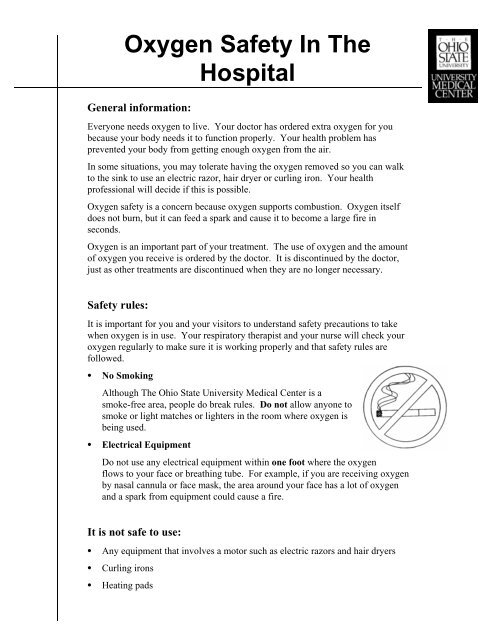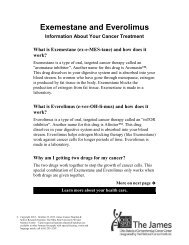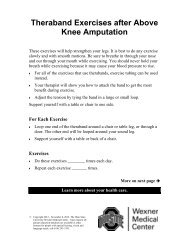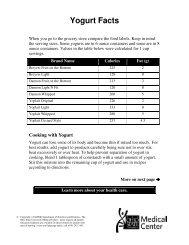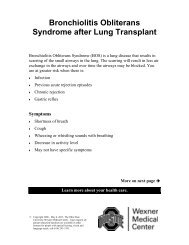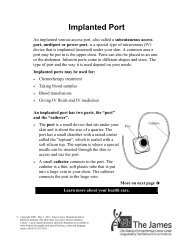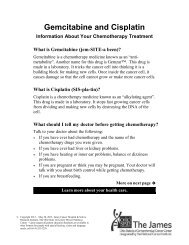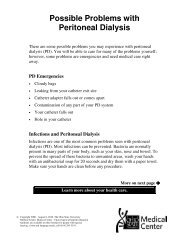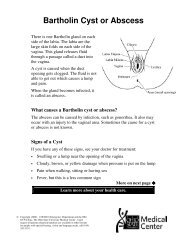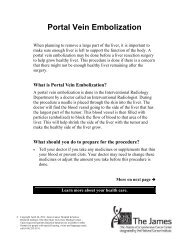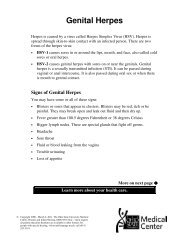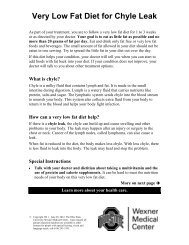Oxygen Safety in the Hospital - Patient Education Home
Oxygen Safety in the Hospital - Patient Education Home
Oxygen Safety in the Hospital - Patient Education Home
You also want an ePaper? Increase the reach of your titles
YUMPU automatically turns print PDFs into web optimized ePapers that Google loves.
<strong>Oxygen</strong> <strong>Safety</strong> In The<br />
<strong>Hospital</strong><br />
General <strong>in</strong>formation:<br />
Everyone needs oxygen to live. Your doctor has ordered extra oxygen for you<br />
because your body needs it to function properly. Your health problem has<br />
prevented your body from gett<strong>in</strong>g enough oxygen from <strong>the</strong> air.<br />
In some situations, you may tolerate hav<strong>in</strong>g <strong>the</strong> oxygen removed so you can walk<br />
to <strong>the</strong> s<strong>in</strong>k to use an electric razor, hair dryer or curl<strong>in</strong>g iron. Your health<br />
professional will decide if this is possible.<br />
<strong>Oxygen</strong> safety is a concern because oxygen supports combustion. <strong>Oxygen</strong> itself<br />
does not burn, but it can feed a spark and cause it to become a large fire <strong>in</strong><br />
seconds.<br />
<strong>Oxygen</strong> is an important part of your treatment. The use of oxygen and <strong>the</strong> amount<br />
of oxygen you receive is ordered by <strong>the</strong> doctor. It is discont<strong>in</strong>ued by <strong>the</strong> doctor,<br />
just as o<strong>the</strong>r treatments are discont<strong>in</strong>ued when <strong>the</strong>y are no longer necessary.<br />
<strong>Safety</strong> rules:<br />
It is important for you and your visitors to understand safety precautions to take<br />
when oxygen is <strong>in</strong> use. Your respiratory <strong>the</strong>rapist and your nurse will check your<br />
oxygen regularly to make sure it is work<strong>in</strong>g properly and that safety rules are<br />
followed.<br />
C No Smok<strong>in</strong>g<br />
Although The Ohio State University Medical Center is a<br />
smoke-free area, people do break rules. Do not allow anyone to<br />
smoke or light matches or lighters <strong>in</strong> <strong>the</strong> room where oxygen is<br />
be<strong>in</strong>g used.<br />
C Electrical Equipment<br />
Do not use any electrical equipment with<strong>in</strong> one foot where <strong>the</strong> oxygen<br />
flows to your face or breath<strong>in</strong>g tube. For example, if you are receiv<strong>in</strong>g oxygen<br />
by nasal cannula or face mask, <strong>the</strong> area around your face has a lot of oxygen<br />
and a spark from equipment could cause a fire.<br />
It is not safe to use:<br />
C Any equipment that <strong>in</strong>volves a motor such as electric razors and hair dryers<br />
C Curl<strong>in</strong>g irons<br />
C Heat<strong>in</strong>g pads
It is safe to:<br />
C Change radio and TV stations<br />
C Use wireless remote controls for VCR's or TV's<br />
C Use <strong>the</strong> telephone<br />
C Use nurse call button if it is one foot away from <strong>the</strong><br />
oxygen flow<br />
C Use bed control if it is one foot away from <strong>the</strong> oxygen flow<br />
O<strong>the</strong>r safety issues:<br />
Page 2<br />
C Do not use petroleum based products, such as Vasel<strong>in</strong>e, Chapstick® or<br />
Blistex® on your lips and nose. Mixtures of oil or petroleum and oxygen can<br />
cause a fire. Surgilube® or o<strong>the</strong>r water based products can be used.<br />
C Never change <strong>the</strong> sett<strong>in</strong>gs on <strong>the</strong> oxygen or turn it off or on. Do not adjust <strong>the</strong><br />
equipment <strong>in</strong> any way. If you are hav<strong>in</strong>g a problem with your oxygen, call<br />
your nurse.<br />
C Do not wear nylon or wool gowns, pajamas or robes because <strong>the</strong>y are more<br />
likely to cause static electricity.<br />
What I need to know when I use oxygen:<br />
C <strong>Oxygen</strong> is an odorless, colorless gas. If you notice an odor, it is most likely<br />
from <strong>the</strong> tub<strong>in</strong>g or mask and it is harmless.<br />
C Most people feel more comfortable while us<strong>in</strong>g oxygen because <strong>the</strong>y can<br />
brea<strong>the</strong> easier. You may feel some dryness <strong>in</strong> your nose and throat. If your<br />
nose becomes dry while gett<strong>in</strong>g oxygen, tell your nurse or respiratory<br />
<strong>the</strong>rapist. Often a humidifier (water bottle) will help <strong>the</strong> feel<strong>in</strong>g of dryness.<br />
C If <strong>the</strong> head strap that keeps <strong>the</strong> oxygen on makes <strong>the</strong> top of your ears sore, tell<br />
your nurse or respiratory <strong>the</strong>rapist. Gauze or foam pads can be wrapped<br />
around <strong>the</strong> straps to pad <strong>the</strong>m.<br />
C Ask your nurse for help when you need to use <strong>the</strong> restroom.<br />
C If you want to walk <strong>in</strong> <strong>the</strong> hall, your nurse or respiratory <strong>the</strong>rapist will get a<br />
portable tank of oxygen for you to use.<br />
If you would like more written <strong>in</strong>formation, please call <strong>the</strong> Library for Health Information<br />
at (614)293-3707. You can also make <strong>the</strong> request by e-mail: health-<strong>in</strong>fo@osu.edu.<br />
© Copyright, (10/2006)<br />
Department of Respiratory Therapy<br />
The Ohio State University Medical Center<br />
< Upon request all patient education handouts are available <strong>in</strong> o<strong>the</strong>r formats for people with special<br />
hear<strong>in</strong>g, vision and language needs, call (614) 293-3191.


